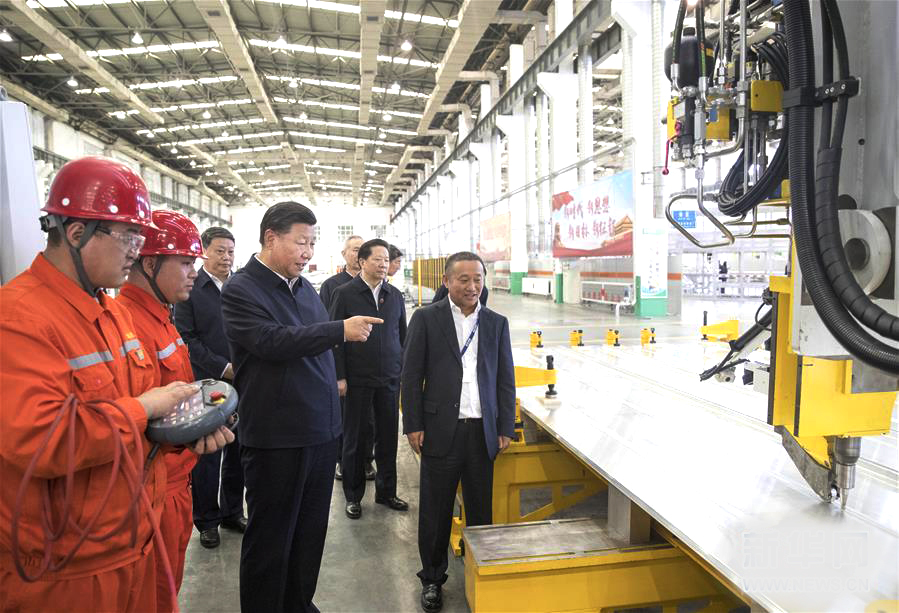Northeast China to rev up engine of reform

President Xi Jinping emphasizes improving the business environment during his visit to Zhongwang Group in Liaoning Province. Photo: XINHUA
Chinese President Xi Jinping called for greater efforts to comprehensively revitalize Northeast China during his recent inspection tour of the region. He chaired a meeting on pushing forward reform efforts, saying that reform should be deepened across the area with the core aim of improving the business environment. We have invited experts to help better understand Xi’s remarks during his visit to Dongbei.
As a major hub of industry and agriculture, China’s northeastern region impacts overall Chinese development. Fundamental reforms in all areas, aiming to improve the business environment, have come into focus in the revitalization of Northeast China. Regional development is supported by capital and talent, which in turn depends on the business environment.
A favorable business environment invites flows of capital and population. At present, Dongbei needs to draw successful experience from other regions in a bid to establish new legal regulation and government offices willing to serve the people, thus attracting human resources from home and abroad to join the cause of revitalization, said Chen Yao, a research fellow from the Institute of Industrial Economics at the Chinese Academy of Social Sciences.
Comprehensive reforms are considered a solution to the problematic circumstances in Dongbei. Governments need to turn the glutted resource-consuming sectors and heavy industry into new growth engines, said Chen Long, a research fellow from the Chinese Academy of Fiscal Sciences. The economy in Northeast China won’t survive on aid from the central government alone. The region inevitably must choose to improve the business environment and stimulate market vitality through reforms, he added.
In recent years, Northeast China’s economy has ailed from crawling sector transformation. Its lack of new growth poles and backward dependence on former advantages form a major structural conflict. To resolve these difficulties, Chen Yao suggested pushing forward the integration of industry and information technology, so that the leading sectors will become more intelligent and traditional manufacturing will make meaningful progress. Also, governments in Dongbei should develop the ability to innovate, to promote emerging sectors and to foster services that can fuel manufacturing, such as industry design, research, development and branding. They should focus on services with huge market potential by putting ecological and cultural resources to good use. Ideally, economic growth patterns in the big cities there will shift from an industrial to a service orientation, Chen Yao said.
The vast reserves of mines, forests and land in China’s northeastern region supply a foundation for developing industry. The region’s featured advantages still exist, such as low population density, quality labor force, excellent education and good infrastructure. The implementation of national strategies will open new opportunities for development, Chen Long suggested.
Dongbei is a major grain production region, making it crucial to the country’s food security. Zhang Lei, deputy director of the Liaoning Academy of Social Sciences, held that grain production and security should give way to ecological protection. Agricultural business entities need to innovate production methods. More efforts in studying agricultural product processing will lead to progress in grain production. The research and promotion of fine seeds is necessary. Also, improved farm mechanization could fuel grain production.
To make the revival a reality, the region should strive for greater openness to cooperation and better connectivity with “Belt and Road” (B&R) facilities. A strategic and global vision is coming to prominence against the backdrop of expanding national openness and the world’s changing political architecture.
Northeast China is situated at the center of Northeast Asia, serving as a hub of cultural and economic exchanges within the area. It has geographical advantage in forming economic cooperation with such countries as Russia, Japan, Mongolia and the Republic of Korea, Chen Long said. Dongbei’s three provinces serve as a window to China’s northern and northeastern neighbors, having tremendous incentive to operate as an export-oriented economy.
The new round of reform requires innovation on cooperation. In a global context, Northeast China should grasp the opportunities brought by the B&R construction to initiate an economic corridor connecting China, Mongolia and Russia. This would form economic partnerships and start cultural exchanges with the Republic of Korea, Japan, Mongolia and Russia, Chen Yao said. Within the country, Dongbei needs to focus on cooperation in the area surrounding the Bohai Sea, especially in the Beijing and Tianjin, by welcoming the sectors and companies moved from the area due to urban restructuring.
(edited by MA YUHONG)

 PRINT
PRINT CLOSE
CLOSE